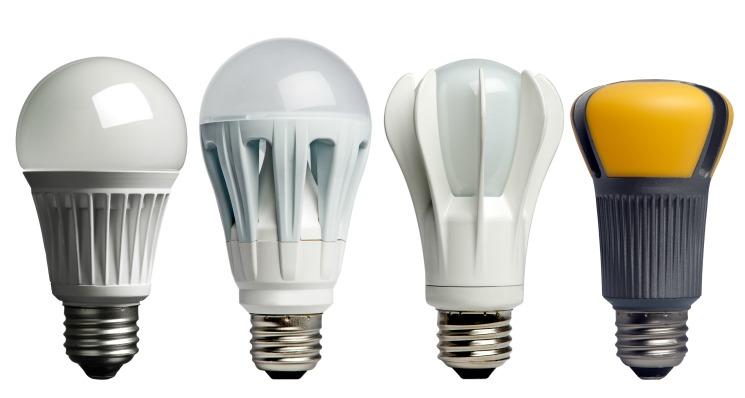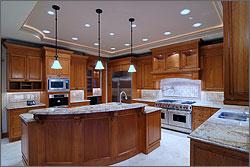
The light-emitting diode (LED) is one of today's most energy-efficient and rapidly-developing lighting technologies. LED lightbulbs last longer, are more durable, and offer better light quality than nearly any other type of lighting available.
Energy Savings
LED is a highly energy efficient lighting technology, and has the potential to fundamentally change the future of lighting in the United States. Residential LEDs -- especially ENERGY STAR rated products -- use at least 75% less energy, and last 25 times longer, than incandescent lighting.
Widespread use of LED lighting has the greatest potential impact on energy savings in the United States. By 2027, widespread use of LEDs could save about 348 TWh (compared to no LED use) of electricity: This is the equivalent annual electrical output of 44 large electric power plants (1000 megawatts each), and a total savings of more than $30 billion at today's electricity prices.
Learn more about How Energy-Efficient Lightbulbs Compare with Traditional Incandescents.
How LEDs are Different
LED lighting is very different from other lighting sources such as incandescent bulbs and CFLs. Key differences include the following:
- Light Source: LEDs are near-monochromatic light sources. They emit various colors (except white) depending on the materials from which they are made.
- Direction: LEDs emit light in a specific direction, reducing the need for reflectors and diffusers that can trap light. This feature makes LEDs more efficient for many uses such as recessed downlights and task lighting. With other types of lighting, the light must be reflected to the desired direction and more than half of the light may never leave the fixture.
- Heat: LEDs emit almost no heat. In comparison, incandescent bulbs release 90% of their energy as heat and CFLs release about 80% of their energy as heat.
LED Products
LED lighting is currently available in a wide variety of home and industrial products, and the list is growing every year. The rapid development of LED technology leads to more products and improved manufacturing efficiency, which also results in lower prices. Below are some of the most common types of LED products.

Industrial and Commercial Lighting
The high efficiency and mono-directional structure of LEDs makes them ideal for many industrial uses. LEDs have largely replaced incandescent bulbs in traffic signals. They are also increasingly common in street lights, automobiles, walkways, computer components, televisions and computer monitors, and signs and displays.

Kitchen Under-Cabinet Lighting
Because LEDs provide such strong lighting in one direction, they are ideal for lighting countertops for cooking and reading recipes. See the Solid-State Lighting website for a quality comparison of incandescents, CFLs, and LEDs in under-cabinet lighting . The color can appear more cool or blue than is typically desirable in a kitchen, and there can be some excessive shadowing in some fixtures, so it is important to compare products to find the best fixture for your space.
Recessed Downlights

Recessed downlights are commonly used in kitchens, hallways, and bathrooms in homes, and have largely replaced ordinary street lights. DOE estimates there are at least 500 million recessed downlights installed in U.S. homes, and more than 20 million are sold each year. Both CFL and LED technology can decrease downlight wattage by 75% or more. See the Solid-State Lighting website for a quality comparison of incandescents, CFLs, and LEDs in downlights .
Portable Desk and Task Lighting
The small size and directionality of LEDs make them well-suited to desk and task lighting. New LED portable lamps appear on the market frequently and performance varies widely. Be sure to evaluate products on an individual basis to check color quality, light output, and energy-efficiency before buying. See the Solid-State Lighting website for a quality comparison of halogens, CFLs, and LEDs in portable task lighting .
Holiday Lights

Decorative light strings such as Christmas tree lights are among the most popular and most affordable LED consumer products on the market. Not only are the LED bulbs far brighter and less yellow in color than incandescent ones, but they save 90% or more in utility costs, operate at cooler temperatures, and have an operational life span of roughly 20,000 hours (enough to last for 40 holiday seasons). In addition, LED lights do not suddenly "burn out," which makes replacing dead bulbs in a string of lights unnecessary.
Advantages of LED Holiday Lights
LED holiday lights have many advantages over ordinary incandescent lights:
- Running LED holiday lights on one 6-foot tree for 12 hours per day for 40 days can save 90% or more energy when compared to traditional incandescent holiday lights:
|
Type of Light |
Electricity Cost * |
|
Standard C-7 |
$27.21 |
|
Mini incandescent lights |
$6.53 |
|
LED holiday lights |
$0.61 |
*Assumes an electricity price of 11.26 cents per kilowatt hour (U.S. Energy Information Administration Average Retail Price of Electricity to Ultimate Customers by End-Use Sector).
- They last longer; they have an operational life span of roughly 20,000 hours, enough to last for 40 holiday seasons
- They are cooler than incandescent bulbs, reducing the risk of fire and personal injury
- They are more durable than incandescent bulbs, with lamps typically made out of solid plastic rather than glass
- Because they use less power, it is safer to connect multiple strings of LED holiday light sets end-to-end without overloading the wall socket.
